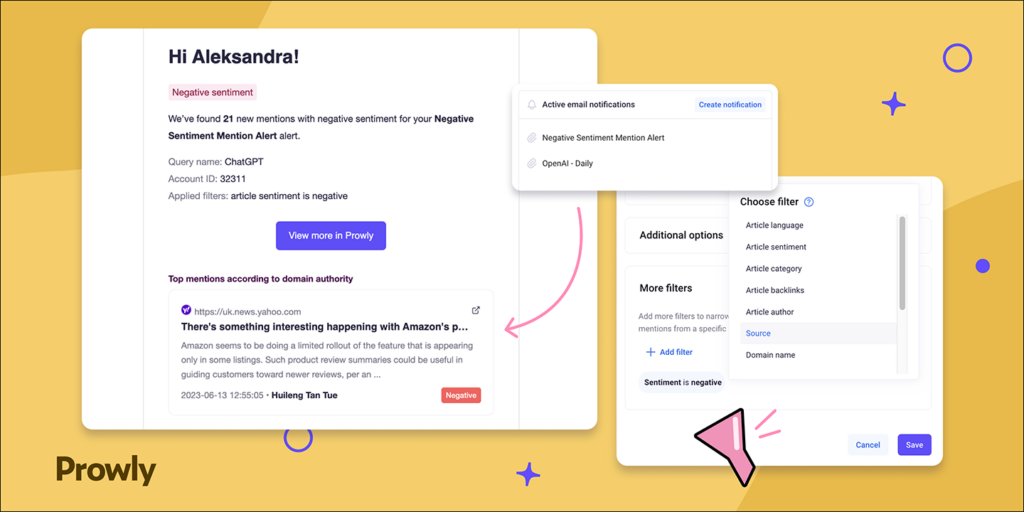The phrase "brand reputation management" sounds like corporate buzzword soup to most people, but chances are it's probably something that's on your mind every day.
After all, your reputation is your brand. Something along the lines of a collective whisper behind your back, the vibe check you kind of slightly missed, and the difference between becoming a success story or a cautionary tale for PR pros.
But brand reputation isn't simply a concern to obsess over. It's a measurable process that has an impact on revenue, customer trust, and long-term growth. And yet too many companies still focus on reactive strategies instead of thinking about it proactively.
Looking for a comprehensive all-in-one PR tool?
Try Prowly completely free for 7 days in a platform with everything you need for PR.
- All-in-one software: Get everything you need in one tool for PR, incl. media database, outreach, reporting, and more
- Transparent pricing: Plans start at $258/month
- Comprehensive monitoring: Track the web and social media mentions.
What is brand reputation management?
Brand reputation management is the process of shaping and influencing the public's perception of a brand. It involves monitoring mentions, responding to feedback and criticism, and building trust to protect a brand's positive image with its audience.
What does brand reputation management include?
More than you'd think. A good reputation management strategy can't be fit into an envelope and left to collect dust. It requires regular updates, attention, and must be fully evangelized within the company.
Here are the basics:
1️⃣ Monitoring perception
You need to be fully aware of what people are saying about your brand.
Whether it's across social media platforms, in online discussion forums, or even in newspaper coverage, your brand reputation can change in an instant if even slight changes in your audience's perception go undetected.
This is why you need to track mentions and customer feedback like a hawk.
💡 If you need a tool to help you out with that, you can try Prowly for free and see how it can help you improve your brand reputation management.
2️⃣ Crisis prevention and response
When negative feedback rolls in (which is inevitable, no matter how great of a brand you represent), you need to address it in the best manner possible. That means no robotic answers, no generic replies.
Additionally, what you can do to alleviate stress in that moment is proactively think about a response strategy before a crisis starts brewing.
💡 Tip: Explore this article to learn more about how reactive PR compares to proactive PR—and how to put it into action.
3️⃣ Brand messaging
Do all of your communications align with your brand values and brand image? It's something to think about in terms of brand reputation strategy as well.
In order to keep it all authentic, you need to know what to say, when to say it and, most importantly, how.
4️⃣ Customer experience
Think about how you're trying to improve as a brand based on customer feedback. Are you taking people's opinions into consideration?
If you're not and your audience feels like they're simply talking to a wall, that's not really building trust and fostering relationships, is it?
Make sure you have a strategy on how to communicate to your audience that you're actively improving upon, respond to reviews and comments with care, and address customer concerns as soon as possible.
P.S. Here’s an article that might come in handy if you’re looking for a tool to measure the impact of your communication efforts.
5️⃣ Competitor benchmarking
Are you really a fan favorite or are you just the loudest in the room?
It's difficult to assess your own performance if you're not benchmarking yourself against your competitors and industry. Try measuring SoV and do a thorough sentiment analysis.
💡 You can read more about these two metrics in these articles:
➖ Share of Voice in PR: How to Calculate Your Brand SOV
➖ How to Use Sentiment Analysis in PR
➖ How to Measure Brand Sentiment in PR
➖ 20+ Top Sentiment Analysis Tools for PR Pros
Who is responsible for brand reputation management?
Well, it depends.
Not necessarily the answer you wanted to see, but brand reputation management is mostly a shared responsibility across multiple departments in the company, such as:
- PR & Communications: To manage media coverage and the public's perception.
- Marketing: To align messaging, brand positioning, and ads.
- Customer support: To respond accurately and swiftly to customer feedback.
- Legal & Compliance: To keep tabs on impersonation, misinformation, and defamation.
- Human Resources: To shape employer branding the right way.
- Leadership: To speak about the brand with confidence and integrity.
What's the difference between brand reputation management and reputation marketing?
| Reputation Management | Reputation Marketing | |
| Primary focus | Protecting and repairing brand image | Promoting a positive brand reputation |
| Approach | Reactive and proactive | Proactive |
| Key activities | Monitoring reviews, addressing customer complaints, managing crises | Displaying positive reviews, creating testimonial content, building trust |
| Goal | To mitigate damage and maintain brand credibility and reputation | To build strong social proof to further grow the business |
P.S. Discover more reputation marketing tips to strengthen your strategy here.
How to measure brand reputation?
#1 Sentiment and customer perception
Knowing how many times your brand was mentioned in the media is as useful as knowing how many times your name was whispered at a party without knowing particularly why. That's why, for all brand-related things, you need to monitor sentiment.

This will help you move beyond counting on sheer volume and allow you to tap into the emotional opinion of the public.
- Why it matters: A spike in mentions isn't always a success, because it may signal a brewing crisis. What helps is to track sentiment alongside volume to get the full story. Not sure where to start? Read more on how to track and analyze brand mentions.
- How to measure: Prowly's media monitoring tools let you track real-time sentiment, create custom alerts, and get a clear picture of your brand reputation management strategy.
#2 Share of Voice vs. Share of Trust
While Share of Voice focuses on how often a brand is being talked about or mentioned relative to its competitors, Share of Trust measures the quality of those mentions and overall reputation, including the audience's emotional responses.
So, which one should you measure? Both!
💡 For example, a high SOV with low brand trust means there's a reputation risk involved. If you're evaluating both SoV and SoT, you'll always know what's up.
#3 What is a reputation score?
It's a number you can benchmark your performance against. There's no general consensus on what this should be—it's more just a metric for you and your brand. It can include:
- Net Promoter Score (NPS): Measures how satisfied and loyal your customers are.
- Brand sentiment: Analyzes the emotional perception and attitude of your audience towards your brand.
- Customer reviews: Track public feedback across platforms like Google, Trustpilot, and others.
- Employee perception: Shows how employees view their workplace experience.
By tracking these factors, brands can gain a more well-rounded picture of how they're actually perceived.
Try Prowly's media monitoring free for 7 days
Start tracking your brand and keywords for free (no credit card required) in Prowly.
- Comprehensive monitoring: Track the web and social media mentions.
- Transparent pricing: Plans start at $258/month
- All-in-one platform: Get everything you need in one tool for PR, incl. media database, outreach, reporting, and more
How to do reputation reporting the right way
What should you include in a reputation report?
When done right, a brand reputation report can turn raw data into powerful insights and give your leadership team the information they need to make strategic decisions.
Such a report should include:
- The impact of media coverage
- Sentiment trends over time
- Shifts in social media engagement
- A crisis risk assessment
- Competitive benchmarking
Keep in mind that you shouldn't just report the hard numbers. What you need to do is deliver a narrative your leadership team can trust, act on, and build a strategy around.
💡 Tip: When choosing a media monitoring service, make sure it’s tailored to local media — for example, the UK market.
Presenting reputation data to leadership
Focus on a story. A sharp, strategic narrative will explain not just what happened, but also why it matters and what to do next. Simply connect the dots for them so they can see the full picture.
Instead of saying "Sentiment dropped 12%," say, "Sentiment fell 12% following our product's recall, but our brand reputation response worked on turning things around, increasing customer trust by 23% within a month."
Additionally, don't say, "Media coverage is up." Say that, "Coverage jumped by 34%, but nearly half was negative, which flagged a potential risk to our strong brand reputation. To work against this, we..."
It's all about how you frame it. Show the cause, the effect, the opportunity, and what you did with it.
Best tools for reputation tracking
Too many software programs to choose from? Choosing the right one depends strictly on your needs, what team you are a part of, how large your brand is, and so on.
Dive into this in-depth analysis of the 13 most popular brand monitoring tools and how to choose the best one for you.
Try Prowly's print monitoring free for 7 days
Start tracking your brand and keywords for free (no credit card required) in Prowly.
- Comprehensive Monitoring: Track the web and social media mentions.
- Transparent Pricing: Plans start at $258/month
- All-in-one platform: Get everything you need in one tool for PR, incl. media database, outreach, reporting, and more
Crisis prevention: spotting risks early
Early warning signs of a reputation crisis
A one-off PR crisis might build up overnight, but a brand reputation crisis?
That doesn't just happen out of nowhere. They like to quietly simmer until something boils them over. The warning signs are usually there, but they're easy to dismiss.
Maybe your company is starting to get more negative brand mentions than usual?
Perhaps a customer complaint goes viral before your team even sees it? Or maybe an industry influencer calls you out and it starts a whole movement?
Keep in mind that these aren't just isolated incidents. Rather, they're signals, and by catching them early, it gives you an edge to respond with intention, not panic.
Reputation risk management framework
Whenever a crisis hits, the last thing you want is to choose a designated person to handle it. It should be when you roll out a previously thought-out reputation management strategy.
Think of it as your brand's emergency blueprint outlining who is responsible for what, how and when to communicate, and what it will take to take control of your story before someone else does.
Choosing the right person to be your spokesperson is key as well. Make sure they have a few statements ready, know how to respond with clarity instead of chaos, and understand the balance between being transparent and protecting the brand.
A good brand reputation management strategy answers these three questions:
1️⃣ Who is responsible for managing a crisis when it happens?
2️⃣ What is the official communication strategy?
3️⃣ How is our brand going to control the narrative?
To summarize? Don't wait until the house is on fire to find the extinguisher.
Real-time reputation monitoring
Checking your brand reputation once a week is something no one does anymore. Think of it as a luxury you just can't afford.
However, with online reputation management tools that help with real-time monitoring, you can easily detect early warning signs. Whether it's information about sentiment shifts, media mentions, or some social chatter, a good tool makes it easier to spot a potential issue before it turns into a full-blown PR crisis.
💡 With Prowly, you can set up an alert for a negative spike in mentions and get the information you need straight to your inbox. That way, you don't need to frantically check stats all the time; you can simply sit back and get an email once something comes up.

Brand protection: safeguarding your reputation
Building a strong brand reputation takes years. However, with today's social media platforms and fast-spreading information, it can all go down in an instant (unless you take all the safety precautions you can).
Preventing brand identity theft and misinformation
Anyone with Wi-Fi can start impersonating your brand on popular channels, so you need to protect your brand reputation as much as you can. Here are a few tips on what to do:
- Monitor online media for impersonations using tools like Prowly to catch fake accounts and any misleading content before it goes viral.
- Secure, verify, and authenticate official brand channels across all platforms.
- Establish an internal escalation process to identify and remove any impersonation attempts, and include your legal team if needed.
- Educate your audience on how to recognize fake accounts and products, and how to report suspicious content moving forward.
Legal and compliance considerations
While your public relations strategies may or may not include legal considerations, in many cases your brand's reputation is protected by law. It's an important thing to remember, especially in stressful situations where your brand is already in deep water.
- Trademark protection helps protect your brand name, logo, and brand assets from being used by others to impersonate you.
- Defamation monitoring ensures you're informed about false claims made about your brand.
- Proactive legal oversight can help in long-term brand reputation management by protecting your brand before issues arise.
Your positive brand reputation is managed through public relations strategies and legal protections, which keeps trouble at bay before it begins.
💡 Pro Tip: Some companies invest in reputation insurance, a specialized form of insurance coverage that helps businesses recover operationally and financially after their public image has been torn.
It includes coverage for costs incurred from public relations efforts, legal fees, and lost revenue. It's something worth considering, especially for brands that rely heavily on brand sentiment and perception.
P.S. If you want to learn all about brand protection along with useful tips and strategies, make sure to read this article.
How to integrate reputation management into marketing and PR?
Reputation-first brand messaging
If your marketing team promises a five-star experience but your customers are barely giving it a two, there's a huge disconnect there which may affect your brand reputation.
Reputation-first messaging means that both your marketing and PR teams are on the same page with what's true to the brand.
Over-promising in advertisements and making unrealistic promises devalues your brand in the long run. What will elevate it is making sure that your messaging reflects the actual customer experience.
This also means that your executives should be media-trained to represent the brand well, ensuring consistency and confidence when they speak about it. Remember that when your brand voice is built on authenticity and transparency, trust will follow naturally.
Investing in thought leadership and influencer partnerships
Strong brand reputation is built not only on what you say about yourself, but also reinforced by who says it about you. Thought leadership and influencer partnerships can help you out with credibility, especially when they come from people that your audience already trusts.
Start posting insightful comments and content from experts and respectable figures in your industry. Choose those who strongly align not only with your brand, but with your brand values as well.
Strengthening reputation with community engagement
So many professionals either forget about this or don't care to put effort into it. Building a strong community around your company is key to positive brand reputation.
Whether you're responding to comments on social media, participating in local events, uplifting local communities, or simply creating spaces for honest conversations online, all of these moments add up.
And this, ladies and gentlemen, is the kind of trust that sticks. People will remember even the smallest interactions and how you made them feel.
A good brand reputation management strategy is an asset
It should be part of your overall business strategy.
To make sure you'll never become a victim of online trolls or a simple misunderstanding blown out of proportion, you need to implement a practice where you monitor brand mentions, measure your standing, and protect your reputation.
Not sure where to start?
👉 Begin with an audit of your current reputation metrics, align your strategy with public relations and marketing efforts, and implement real-time monitoring.
Try Prowly's media monitoring free for 7 days
Start tracking your brand and keywords for free (no credit card required) in Prowly.
- Comprehensive monitoring: Track the web and social media mentions.
- Transparent pricing: Plans start at $258/month
- All-in-one platform: Get everything you need in one tool for PR, incl. media database, outreach, reporting, and more

